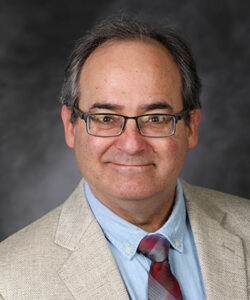Flexibility, affordability and practicality
As UND’s student population trends older, more online and more diverse, expect to hear those watchwords more often, Task Force panelists say
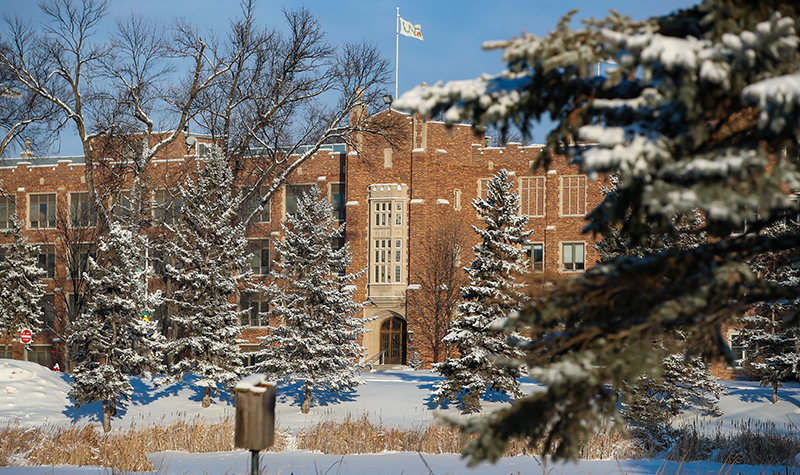
Two questions capture the enrollment and educational challenge facing UND, said Jeff Holm, the University’s Vice Provost for Online Education and Strategic Planning:
Whom will we serve?
And how will we serve them?
But the fog hiding the answers lifted a bit last week at a UND Task Force on the Future of Education seminar. That’s where Holm and others described UND’s long-term enrollment trends, as well as the educational practices that the emerging populations of students likely will call for.
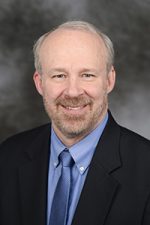
“Clearly, we’re going to be dealing with students who are older than the typical, traditional undergrad of 18 to 22,” Holm said.
“They’re going to be more racially and ethnically diverse. They’re going to be much more likely to be enrolled part-time, and much more likely to be employed. …
“And they’re not interested in adapting to our structure,” Holm continued.
“They’re not interested in fitting into the college structure that we construct, that we create as faculty, instructors, staff, administration or a higher education institution. They’re looking for a program that they can make work, given that they have families, jobs, children that they are responsible for, and so on.”
Expect life at UND to evolve as a result, Holm said.
The Task Force on the Future of Education, an initiative launched by UND Interim Provost Debbie Storrs, is charged with educating the University community about the big issues facing UND and higher education today. The seminar on Feb. 24 was titled “Ensuring Educational Opportunities at UND Continue Into the Future,” and it was hosted on Zoom by Task Force co-chairs Jeff VanLooy, associate professor of Earth System Science & Policy, and John Shabb, associate professor of Biomedical Sciences.
Besides Vice Provost Holm, the panelists were Amanda Haage, Assistant Professor of Biomedical Sciences at UND; Robert Warren, Marketing Instructor at the University; and Dawson Dutchak, UND student and Chief of Staff to the Vice President of Student Government.
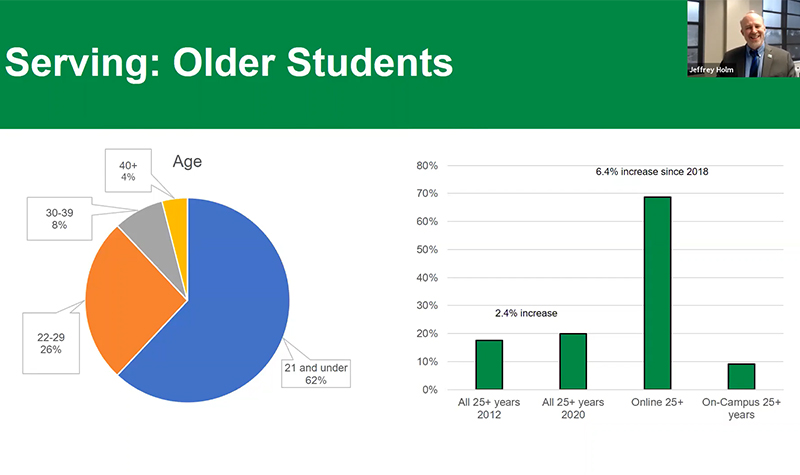
Older, more online and more diverse
Holm began by showing PowerPoint slides that documented the larger enrollment trends.
Today, only about 8 percent of full-time UND students are 25 or older, Holm said. That’s below the national average of 10 percent for four-year public colleges.
But the UND numbers are trending upward, especially among online students who are 25 or older: up more than 6 percent since as recently as 2018. Likewise, more than half of part-time students at UND are 25 or older, significantly higher than the national four-year-public-college average of between 40 and 50 percent.
“The point being, we’re seeing older students among our undergraduate students, and that trend is very, very likely to continue,” Holm said. “So, we are serving more of them and will likely continue to serve more of them.”

The same holds true for students of color. Currently, and in large part due to the demographics of North Dakota, only 16 percent of UND’s undergraduate population is made up of students of color. That’s far below the national average of 44 percent at four-year public institutions.
“But nonetheless, we’ve seen a 5 percent increase in students of color since 2012,” Holm said. “And in the online space, that’s an even higher percentage. We’re almost at 25% in the online space.
“Again, I’m expecting that trend will continue.”
Meanwhile, UND also has been seeing especially strong growth in the number of part-time students. It’s up 7.6 percent since 2012 to about 26 percent of all students, or about the national average.
Moreover, “the percentage is much higher in the online space, as those of you who are faculty and instructors are probably aware,” Holm said. “It’s almost 80 percent – in other words, almost 80 percent of our online undergraduates are part time students. And most of those are employed as well.”
So, how will UND serve this emerging population of older, more diverse and more likely to be part-time-and-employed students?
Flexibility
Flexibly, Holm and the other panelists agreed.
For example, “if you think of ‘fully in-person’ at one end of the course-delivery spectrum and ‘fully online’ at the other, you’ll find a lot of interesting possibilities in between,” Holm said.
“I think more and more, you’re going to see offerings not being fully online or fully in person, but in a blended sense.”
Also, the curricula that students encounter likely will be more personalized than college students traditionally have encountered. That doesn’t mean less rigorous. It means:
• Set up to take students’ prior learning and life experiences into account
• Scheduled in ways that will allow students to progress faster or slower than the semester system
• Culminating at times in academic and/or industry certificates, rather than degrees
• Integrated with internships, team projects for government agencies or private organizations, and other workforce-integration skills
• And “scaffolded” or “laddered” to award badges or micro-credentials as students progress to their certificate or degree.

Assistant Professor Amanda Haage is one faculty member who’s already incorporating some of these insights into her classrooms. Haage recently turned UND’s standalone human anatomy and human physiology courses into a single course, and revamped the course delivery system in the process. Today, she said, Human Anatomy & Physiology students progress through 14 content badges that are arranged in three tiers, from beginner to advanced.
The color-coded badges appear on all of the science content throughout the course, Haage said. This reminds students of the skills they’re learning, motivates them to keep advancing and gives Haage a useful visual and organizational tool.
Moreover, achieving each badge can happen, to an extent, at each students’ own pace.
Haage’s inspiration for this method? Video games.
Don’t laugh: These tools are much more in your life than you might think, she said.
For evidence, just tap on your phone. There you’ll find fitness apps, language-learning apps and many other popular programs that use these techniques to motivate users and hold their interest.
All that plus well-organized, learn-at-your-own-pace and accessible-to-all subject matter: “That’s what I think the value is in using these kinds of models in higher ed,” she said.
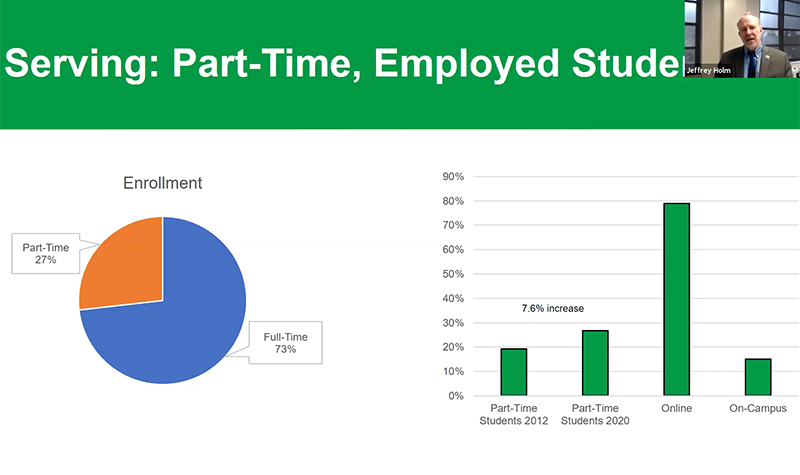
Practicality
Marketing Instructor Robert Warren adds another innovative element to his classrooms: interacting with the community. Too often, “the University is seen as having a moat around it,” he said. “And that can create bad relations.
“So what I try to do is provide a bridge that gives the students a great opportunity, but also gets us into the community,” he said.
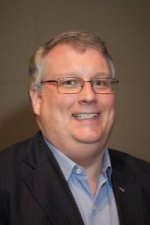
That happens using platforms such as Riipen (pronounced “ripen”), a platform that lets faculty members find course-relevant projects in the private sector for students to complete. This helps the students turn classroom theory into real-world workplace skills, “and shows the community how we can solve problems that are out there,” he said.
“What I’ve found over time is that these projects are hugely important to the students, and also are very well received by the community.”
On balance, students welcome these developments, said Dawson Dutchak, Chief of Staff to the Vice President of Student Government and a double major in Public Affairs and Human Resource Management.
But UND should keep a few other key factors in mind, especially if it wants to attract students from all parts of society and walks of life.
Affordability
One such factor is affordability. “I can’t stress this enough,” he said. All but the richest students fret about whether they can afford college, and all students – including the richest – want to make sure their UND education is worth the money.
“That leads me to the next thing I want to focus on, which is finding a purpose,” he said.
In general, students arrive lacking a clear picture of not only what they want to study at UND, but also the full range of UND’s offerings. So, the more the University can explain what’s available and help students explore different options, the better, he said.
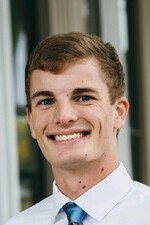
Last but not least, it’s no accident that all of the faculty panelists mentioned skills training, because it’s vital, Dutchak said.
Think of it this way: “We live in an age where knowledge is abundant,” he said. “I can go on Google right now, and I can learn pretty much anything that I want to. So, knowing things is no longer the barrier to finding a career or being successful.
Instead, “it’s knowing how to do things and having transferable skills,” he said.
Add flexible approaches that give students more control – do I want to attend class in person today, or watch the lecture online? Do I want to take a class with no time limit along with my regular semester coursework? – and UND would be positioned well, Dutchak said.
“Have that flexibility, make sure it’s affordable, and make sure that students come out of the University with skills, not just knowledge,” he summarized.
“I think that those are the core components of where UND can move forward, and really advance education to the digital age and the next generation of students.”
A video of the full seminar is available at the web page of the UND Task Force on the Future of Education.
